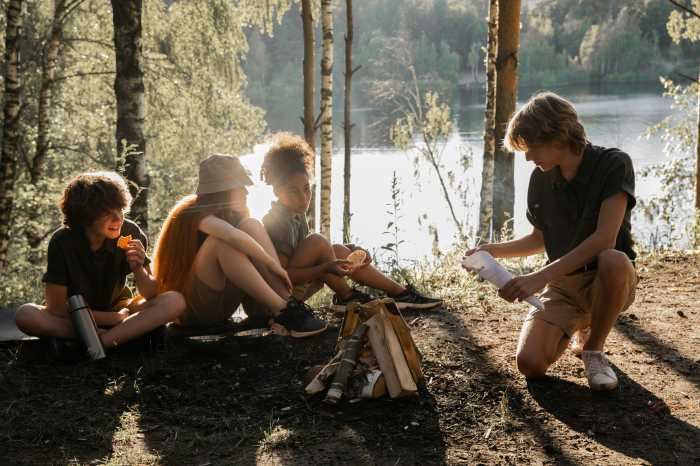“Twinkle, twinkle, little star, how I wonder what you are?”
While almost every child can recite this poem by heart, for many, their knowledge of astronomy ends there. That’s a shame because stargazing has so much to offer. “Astronomy is a great hobby that’s rich with opportunities. Children learn how to observe, describe and interpret the world around us,” says Katie Moore, astronomy educator at the Smithsonian National Air and Space Museum in Washington, D.C. Wondering how you can introduce your family to the wonders of astronomy? Then, read on.
For Your Eyes Only
Find an open area where you can observe the sky with your naked eye. A high school’s stadium, an empty parking lot or a local sports field can be good observation sites. “For the very young, it’s most important for children to notice and describe, not explain,” says Moore. So don’t be overly concerned about naming objects or explaining concepts. Instead, have fun watching the stars and constellations, their movement across the sky, and the planets as they wander among the constellations.
“Astronomy at the preschool and young elementary age should be all about noticing what the sky looks like at different times of day, the night and the year,” says Moore. For families new to astronomy, the stars are a great place to start. Although, at first glance, the stars might all look alike, they differ in size, brilliance and color. To help your child see these differences, ask questions. What do you notice about the appearance of stars? Can you find a very bright star? Are the stars all the same color?
Children can also learn a lot by observing the moon. Point out the darker regions and brighter regions and invite your kids to imagine what might be there. Observing the moon is also a good way to introduce children to the concept of orbits and lunar phases. “Children can look for the Moon each day and draw a picture of its shape,” says Moore. Again, use questions to engage young minds. Can we see the moon during the day? Where does the moon go when we can’t see it? Is the moon always in the same place every night? What shape do the dark and light regions make? What do you think the moon’s surface is like?
You can also use stories to help your children learn about the constellations. Younger children, especially, enjoy hearing the stories and myths that people associate with the constellations. You can find many good books at the local library that illustrate the various constellations and give you tips on how to locate them in the sky. Check out our favorite astronomy books for kids.
After your family has identified a few constellations, you can do some at-home projects. For example, have your child choose a favorite constellation and recreate it on paper, using a pencil or stickers to show where each star is. Next, help your child to connect the dots. Ask your child to describe what he sees. Some constellations, like the Big Dipper, are easier to visualize than others. Older children can download free monthly maps at www.skymaps.com or visit NASA’s Astronomy Picture of the Day for a different image each day along with an explanation by a professional astronomer.
CLICK NEXT TO LEARN ABOUT BINOCULARS AND TELESCOPES
Bring on the Binoculars
After your family has become familiar with the stars and constellations, Moore recommends using binoculars for sky watching. Children under age 4 have a tendency to look at the lenses of a binocular, instead of through them, so make sure they have a chance to practice using binoculars before you go on an astronomy outing. Kids can check out the smaller craters and other features on the surface of the moon. They can compare how stars and planets look with and without the binoculars. Remember to use questions. Are there more stars in one area of the sky than another? What colors do stars have?
Time for the Telescope
As your family becomes more interested in astronomy, you may want to use a telescope. Younger children may need to be taught to use only one eye to look through the eyepiece. “Even with a very basic telescope, you will be able to notice some things: Venus has phases like the Moon. Jupiter’s four moons look like tiny stars as they orbit the planet. Saturn has rings,” says Moore. If you’ve got older children, consider joining your local astronomy club for help using telescopes, sky maps, moon calendars and moon maps. Again, questions will help your children learn. How can you tell the difference between a star and a planet? How many rings do you see? What phase is Venus in tonight?
At the Public Observatory, at the National Air and Space Museum (NASM) on the National Mall in Washington, D.C., visitors can observe the Sun through safe solar telescopes, as well as the Moon or planets when they are available for viewing during the daytime. NASM’s Einstein Planetarium offers free educational programs most days. Many state and regional parks offer stargazing programs. At gewa.gsfc.nasa.gov you can see a list of astronomy clubs, organizations, news and online resources.
Stargazing is a wonderful way for parents and children to connect. So, instead of wishing on the stars, get outside and marvel at them!
Justine Ickes is a freelance writer and mom to two boys. They love watching for satellites and shooting stars.
Click here for a list of local planetariums and astronomy clubs.















